Extraction of Dibenzyl Disulfide from Transformer Oils by Acidic Ionic Liquid
Abstract
1. Introduction
2. Results and Discussion
2.1. Desulfurization Performance of ILs
2.2. Effect of Molar Ratios of FeCl3/[BMIM]Cl on DBDS Extraction
2.3. Extraction Properties of ILs towards Other Sulfur Species
2.4. Determination of the Equilibrium Time
2.5. Effect of Extraction Temperature on Desulfurization Performance of ILs
2.6. Comparison with Other Extractants
2.7. Accumulative Extraction of [BMIM]FeCl4
2.8. The Possible Extraction Mechanism
2.9. Regeneration of [BMIM]FeCl4
3. Material and Method
3.1. Materials
3.2. Preparation of [BMIM]Cl·xFeCl3
3.3. Extractive Desulfurization Experiment
3.4. Separation Parameter Determination
3.5. Theoretical Calculation
3.6. Regeneration of [BMIM]FeCl4
4. Conclusions
Supplementary Materials
Author Contributions
Funding
Institutional Review Board Statement
Informed Consent Statement
Data Availability Statement
Conflicts of Interest
References
- Dukhi, V.; Bissessur, A.; Martincigh, B.S. Formation of Corrosive Sulfur with Dibenzyl Disulfide in Fluid-Filled Transformers. Ind. Eng. Chem. Res. 2016, 55, 2911–2920. [Google Scholar] [CrossRef]
- Scatiggio, F.; Tumiatti, V.; Maina, R.; Tumiatti, M.; Pompili, M.; Bartnikas, R. Corrosive sulfur induced failures in oil-filled electrical power transformers and shunt reactors. IEEE Trans. Power Deliv. 2009, 24, 1240–1248. [Google Scholar] [CrossRef]
- Matejkova, M.; Kastanek, F.; Maleterova, Y.; Kuzilek, V.; Kosanova, L.; Solcova, O. Removal of corrosive sulfur from insulating oils by natural sorbent and liquid-liquid extraction. IEEE Trans. Dielectr. Electr. Insul. 2017, 24, 2383–2389. [Google Scholar] [CrossRef]
- Gao, S.; Yang, L.; Deng, B.; Zhang, J. Corrosion mechanism for local enrichment of acids and copper ions in copper-insulating paper contacts leading to the acceleration of copper sulfide formation induced by dibenzyl disulfide. RSC Adv. 2017, 7, 52475–52485. [Google Scholar] [CrossRef]
- Toyama, S.; Tanimura, J.; Yamada, N.; Nagao, E.; Amimoto, T. Highly sensitive detection method of dibenzyl disulfide and the elucidation of the mechanism. IEEE Trans. Dielectr. Electr. Insul. 2009, 16, 509–515. [Google Scholar] [CrossRef]
- IEC 60296; Fluids for Electrotechnical Applications—Unused Mineral Insulating Oils for Transformers and Switch-Gear. International Electrotechnical Commission: Geneva, Switzerland, 2012.
- Dahlund, M.; Lorin, P.; Werle, P. Effects of on-line reclaiming on the corrosive sulphur content of transformer oil. CIGRE SC A 2009, 2, A3. [Google Scholar]
- Maina, R.; Tumiatti, V.; Pompili, M.; Bartnikas, R. Corrosive sulfur effects in transformer oils and remedial procedures. IEEE Trans. Dielectr. Electr. Insul. 2009, 16, 1655–1663. [Google Scholar] [CrossRef]
- Safiddine, L.; Fofana, I.; Skender, A.; Guerbas, F.; Boucherit, A.; Zafour, A.H.-Z. Transformer oil reclamation by combining several strategies enhanced by the use of four adsorbents. IET Gener. Transm. Distrib. 2017, 11, 2912–2920. [Google Scholar] [CrossRef]
- Jiang, W.; Zhu, W.; Chang, Y.; Chao, Y.; Yin, S.; Liu, H.; Zhu, F.; Li, H. Ionic liquid extraction and catalytic oxidative desulfurization of fuels using dialkylpiperidinium tetrachloroferrates catalysts. Chem. Eng. J. 2014, 250, 48–54. [Google Scholar] [CrossRef]
- Yang, L.; Gao, S.; Deng, B.; Zhang, J.; Sun, W.; Hu, E. Inhibition method for the degradation of oil–paper insulation and corrosive sulphur in a transformer using adsorption treatment. IET Gener. Transm. Distrib. 2016, 10, 1893–1900. [Google Scholar] [CrossRef]
- Wan, T.; Feng, B.; Zhou, Z.; Qian, H.; Gong, S.K. Removal of corrosive sulfur from insulating oil with adsorption method. IEEE Trans. Dielectr. Electr. Insul. 2015, 22, 3321–3326. [Google Scholar] [CrossRef]
- Lukić, J.M.; Nikolić, D.; Mandić, V.; Glisić, S.B.; Antonović, D.; Orlović, A.M. Removal of sulfur compounds from mineral insulating oils by extractive refining with N-methyl-2-pyrrolidone. Ind. Eng. Chem. Res. 2012, 51, 4472–4477. [Google Scholar] [CrossRef]
- Kumar, S.; Srivastava, V.C.; Raghuvanshi, R.; Nanoti, S.M.; Sudhir, N. Removal of Refractive Sulfur and Aromatic Compounds from Straight-Run, Fluidized Catalytic Cracking, and Coker Gas Oil Using N-Methyl-2-pyrrolidone in Batch and Packed-Bed Extractors. Energy Fuels 2015, 29, 4634–4643. [Google Scholar] [CrossRef]
- Nie, Y.; Li, C.-X.; Wang, Z.-H. Extractive desulfurization of fuel oil using alkylimidazole and its mixture with dialkylphosphate ionic liquids. Ind. Eng. Chem. Res. 2007, 46, 5108–5112. [Google Scholar] [CrossRef]
- Li, H.; Zhang, B.; Jiang, W.; Zhu, W.; Zhang, M.; Wang, C.; Pang, J.; Li, H. A comparative study of the extractive desulfurization mechanism by Cu(II) and Zn-based imidazolium ionic liquids. Green Energy Environ. 2019, 4, 38–48. [Google Scholar] [CrossRef]
- Le Bui, T.T.; Nguyen, D.D.; Van Ho, S.; Nguyen, B.T.; Uong, H.T.N. Synthesis, characterization and application of some non-halogen ionic liquids as green solvents for deep desulfurization of diesel oil. Fuel 2017, 191, 54–61. [Google Scholar] [CrossRef]
- Butt, H.S.; Lethesh, K.C.; Fiksdahl, A. Fuel oil desulfurization with dual functionalized imidazolium based ionic liquids. Sep. Purif. Technol. 2020, 248, 116959. [Google Scholar] [CrossRef]
- Ghandi, K. A review of ionic liquids, their limits and applications. Green Sustain. Chem. 2014, 4, 44–53. [Google Scholar] [CrossRef]
- Rodríguez, H.; Francisco, M.; Soto, A.; Arce, A. Liquid–liquid equilibrium and interfacial tension of the ternary system heptane+thiophene+1-ethyl-3-methylimidazolium bis(trifluoromethanesulfonyl)imide. Fluid Phase Equilibria 2010, 298, 240–245. [Google Scholar] [CrossRef]
- Gao, J.-J.; Li, H.-Q.; Zhang, H.-X.; Lu, Y.-Z.; Meng, H.; Li, C.-X. Removal mechanism of thiophenic compounds in model oil by inorganic Lewis acids. Ind. Eng. Chem. Res. 2012, 51, 4682–4691. [Google Scholar] [CrossRef]
- Gao, J.; Dai, Y.; Ma, W.; Xu, H.; Li, C. Efficient separation of phenol from oil by acid–base complexing adsorption. Chem. Eng. J. 2015, 281, 749–758. [Google Scholar] [CrossRef]
- Chen, X.; Yuan, S.; Abdeltawab, A.A.; Al-Deyab, S.S.; Zhang, J.; Yu, L.; Yu, G. Extractive desulfurization and denitrogenation of fuels using functional acidic ionic liquids. Sep. Purif. Technol. 2014, 133, 187–193. [Google Scholar] [CrossRef]
- Bösmann, A.; Datsevich, L.; Jess, A.; Lauter, A.; Schmitz, C.; Wasserscheid, P. Deep desulfurization of diesel fuel by extraction with ionic liquids. Chem. Commun. 2001, 23, 2494–2495. [Google Scholar] [CrossRef] [PubMed]
- Ko, N.H.; Lee, J.S.; Huh, E.S.; Lee, H.; Jung, K.D.; Kim, H.S.; Cheong, M. Extractive Desulfurization Using Fe-Containing Ionic Liquids. Energy Fuels 2008, 22, 1687–1690. [Google Scholar] [CrossRef]
- Li, F.-T.; Wu, B.; Liu, R.-H.; Wang, X.-J.; Chen, L.-J.; Zhao, D.-S. An inexpensive N-methyl-2-pyrrolidone-based ionic liquid as efficient extractant and catalyst for desulfurization of dibenzothiophene. Chem. Eng. J. 2015, 274, 192–199. [Google Scholar] [CrossRef]
- Lukić, J.; Orlović, A.; Spiteller, M.; Jovanović, J.; Skala, D. Re-refining of waste mineral insulating oil by extraction with N-methyl-2-pyrrolidone. Sep. Purif. Technol. 2006, 51, 150–156. [Google Scholar] [CrossRef]
- Li, F.-T.; Kou, C.-G.; Sun, Z.-M.; Hao, Y.-J.; Liu, R.-H.; Zhao, D.-S. Deep extractive and oxidative desulfurization of dibenzothiophene with C5H9NO·SnCl2 coordinated ionic liquid. J. Hazard. Mater. 2011, 205, 164–170. [Google Scholar] [CrossRef]
- Martínez-Magadán, J.-M.; Oviedo-Roa, R.; García, P.; Martínez-Palou, R. DFT Study of the Interaction between Ethanothiol and Fe-containing Ionic Liquids for Desulfurization of Natural Gasoline. Fuel Process. Technol. 2012, 97, 24–29. [Google Scholar] [CrossRef]
- Li, H.; Chang, Y.; Zhu, W.; Jiang, W.; Zhang, M.; Xia, J.; Yin, S.; Li, H. A DFT study of the extractive desulfurization mechanism by [BMIM]+[AlCl4]- ionic liquid. J. Phys. Chem. B 2015, 119, 5995–6009. [Google Scholar] [CrossRef]
- Tsuzuki, S.; Tokuda, H.; Hayamizu, K.; Watanabe, M. Magnitude and Directionality of Interaction in Ion Pairs of Ionic Liquids: Relationship with Ionic Conductivity. J. Phys. Chem. B 2005, 109, 16474–16481. [Google Scholar] [CrossRef]
- Gao, J.; Zhu, S.; Dai, Y.; Xiong, C.; Li, C.; Yang, W.; Jiang, X. Performance and mechanism for extractive desulfurization of fuel oil using modified polyethylene glycol. Fuel 2018, 233, 704–713. [Google Scholar] [CrossRef]
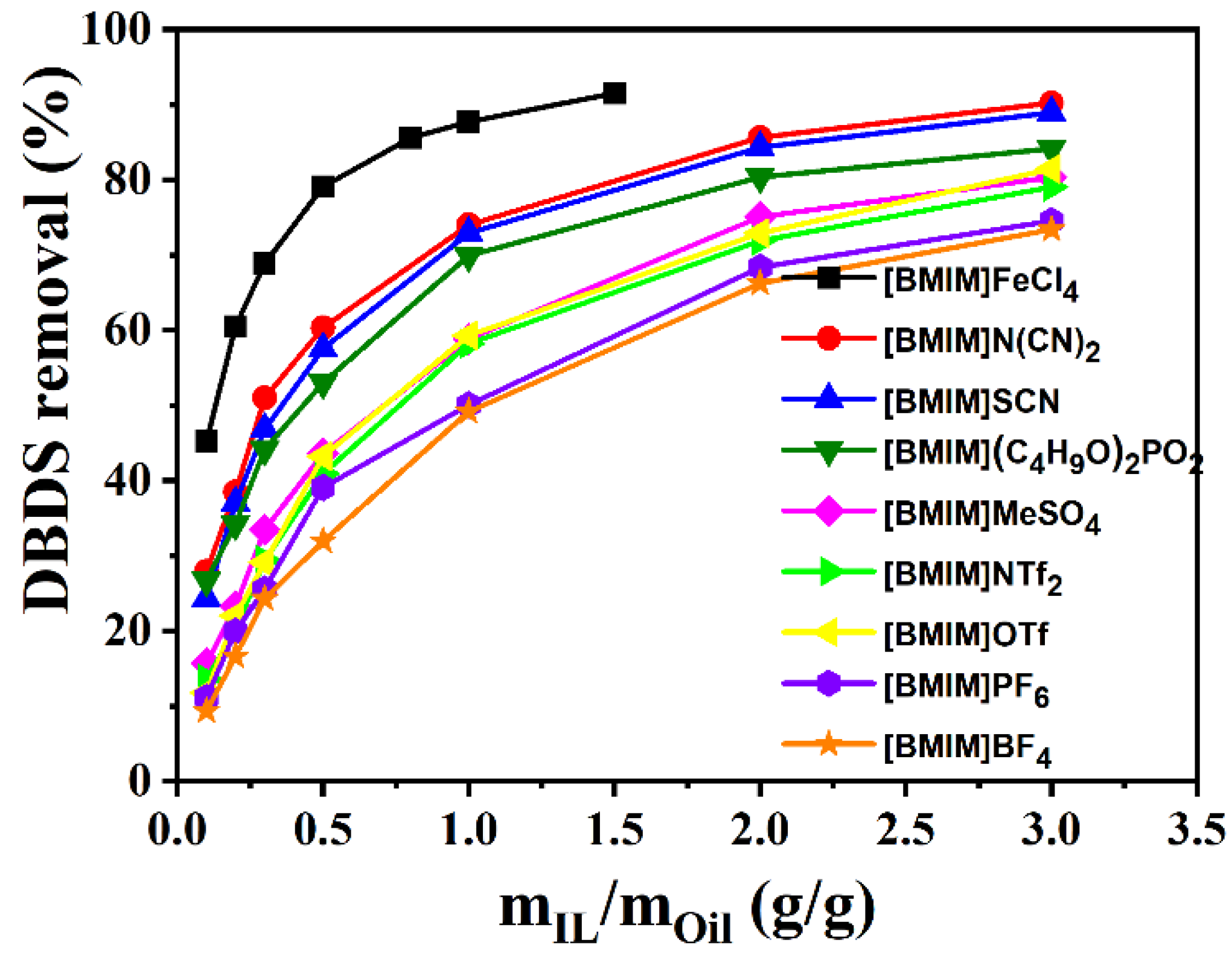
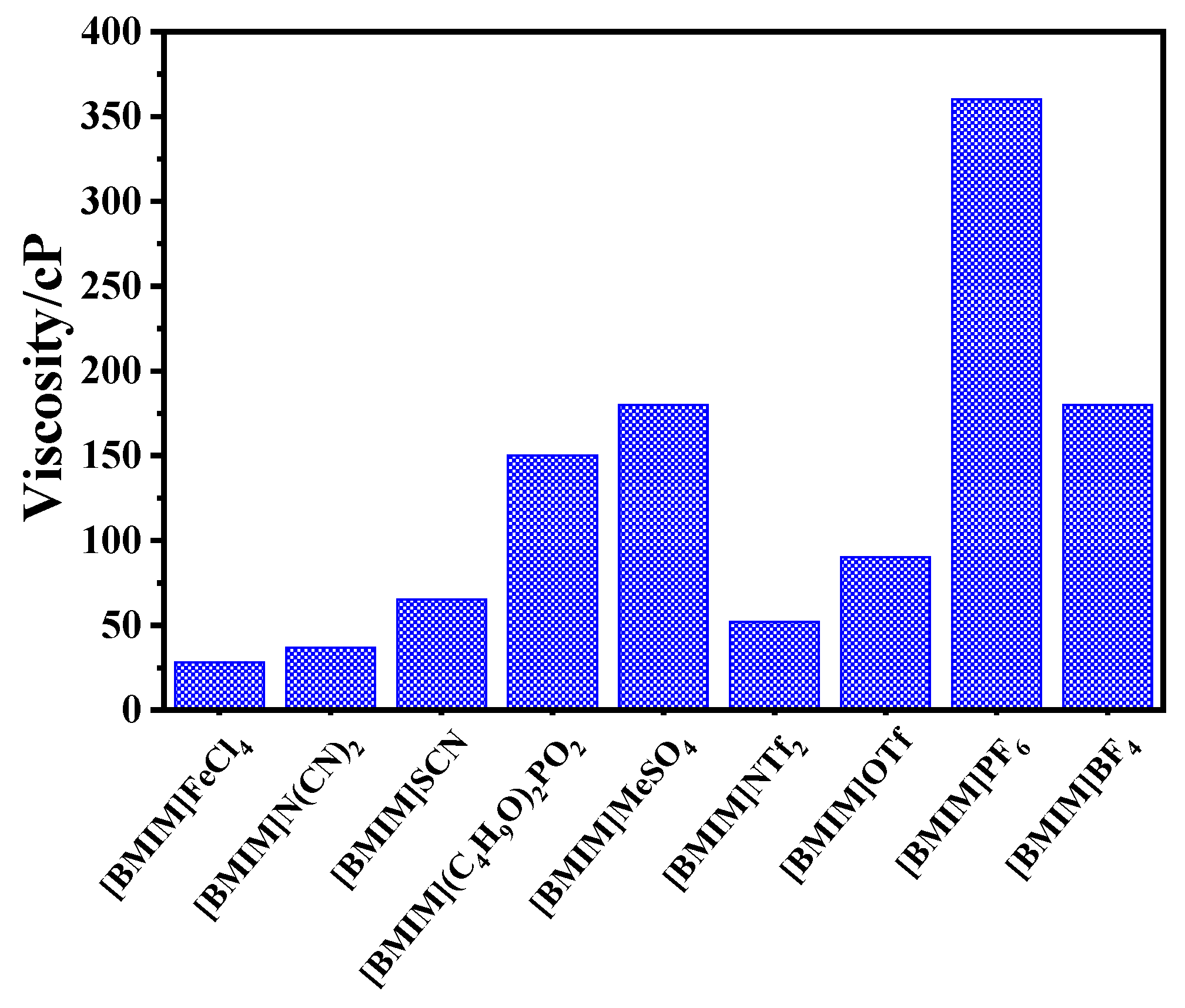
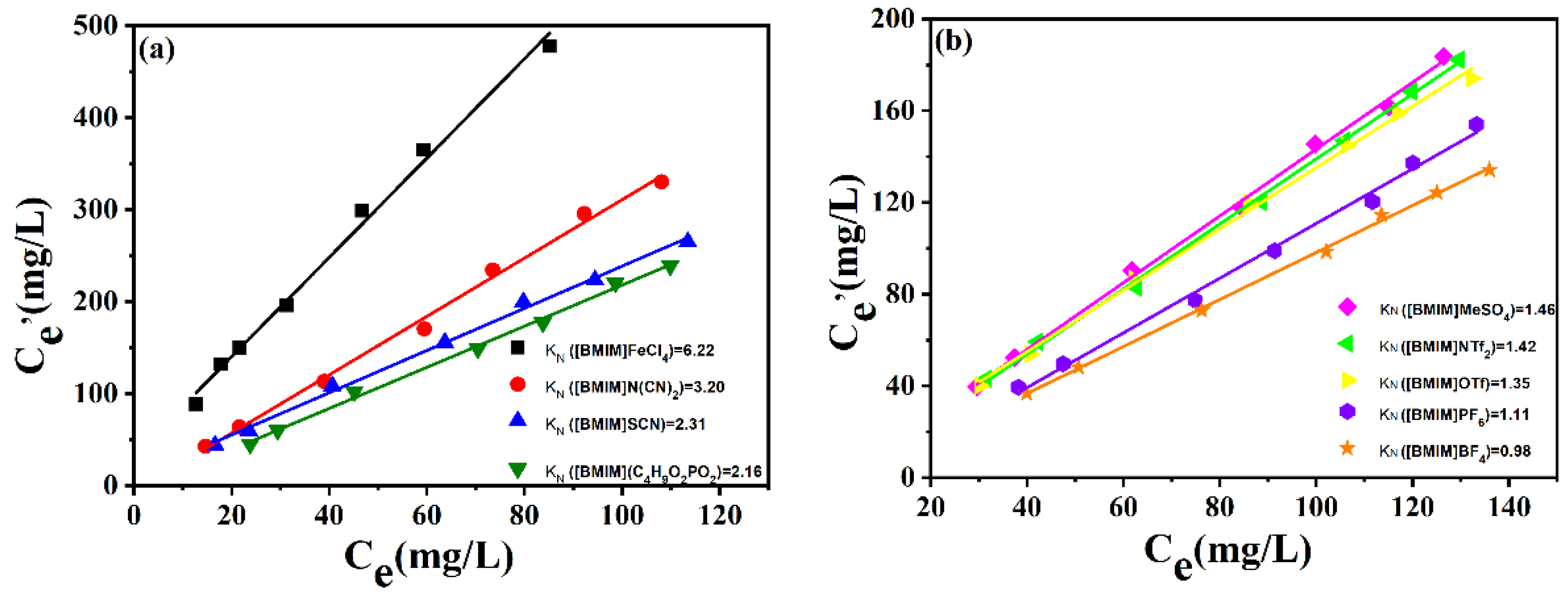
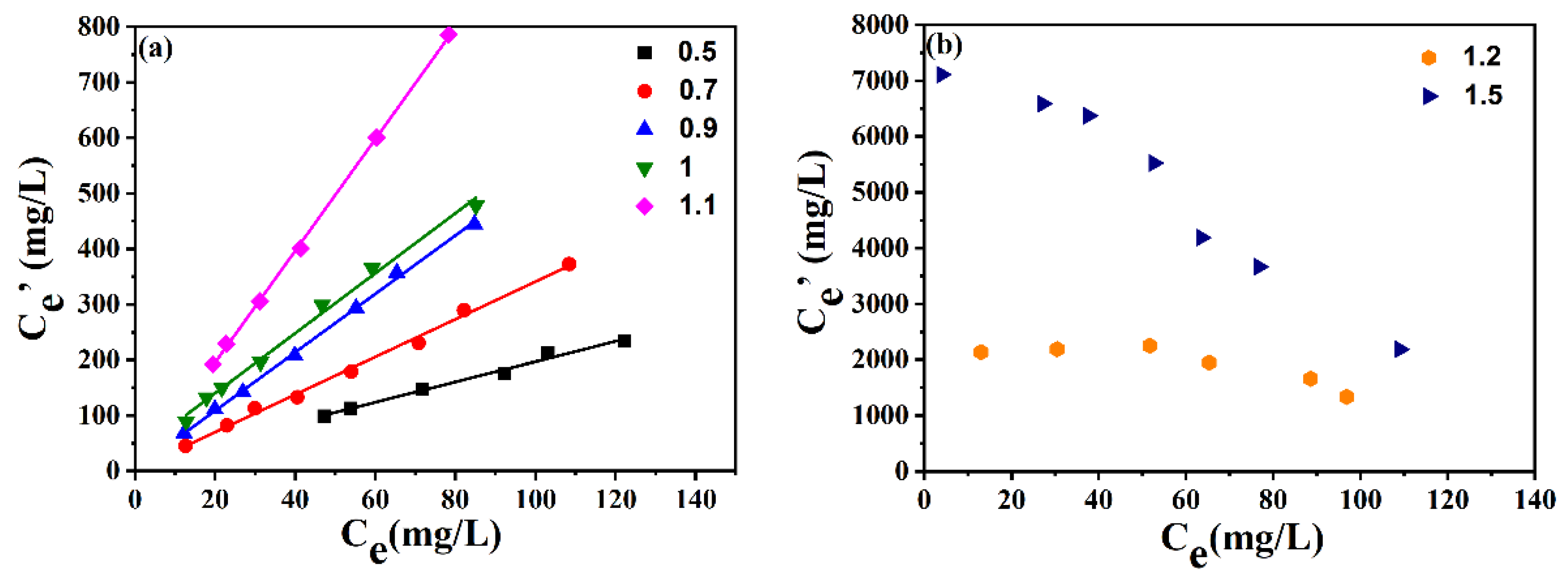

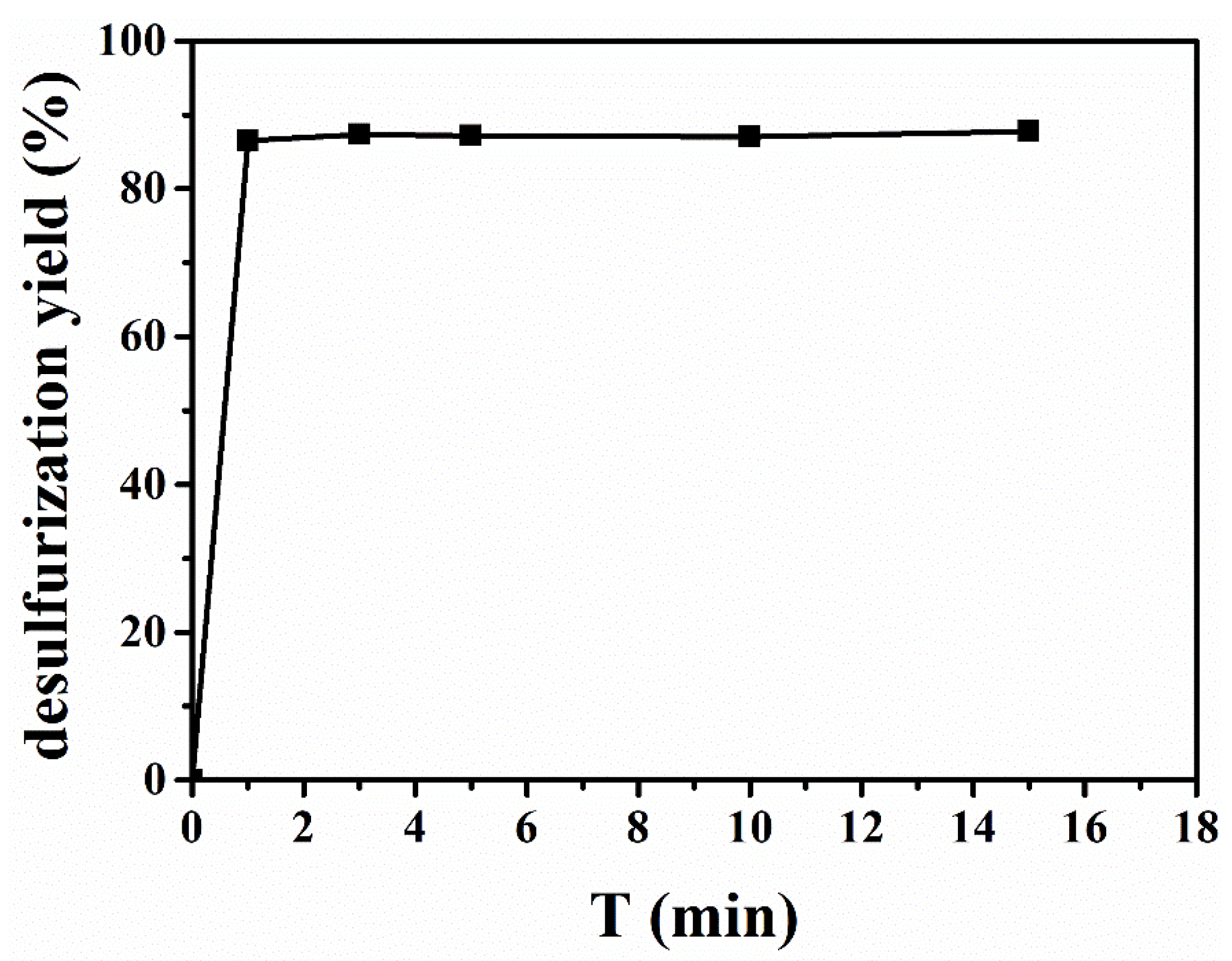
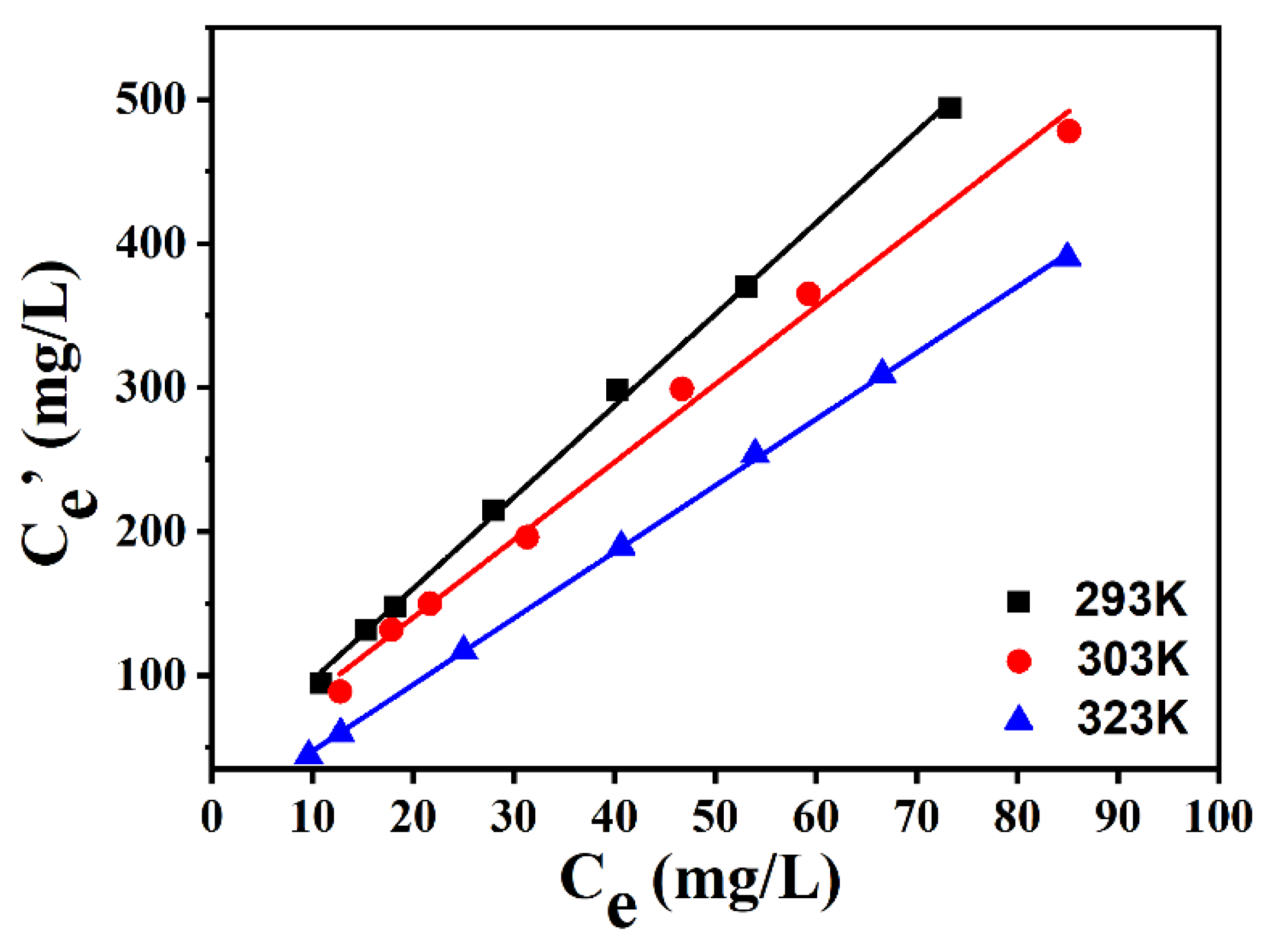
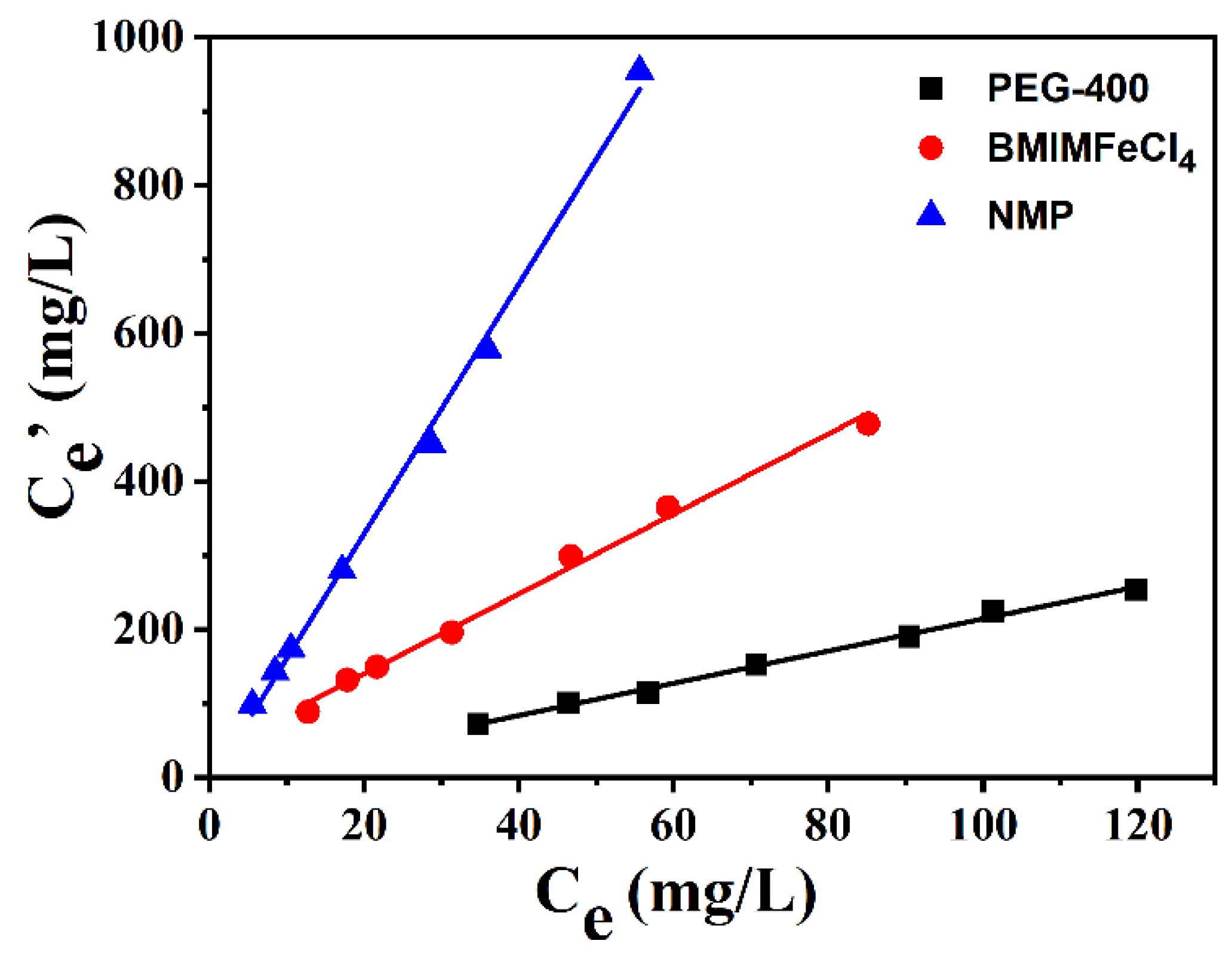

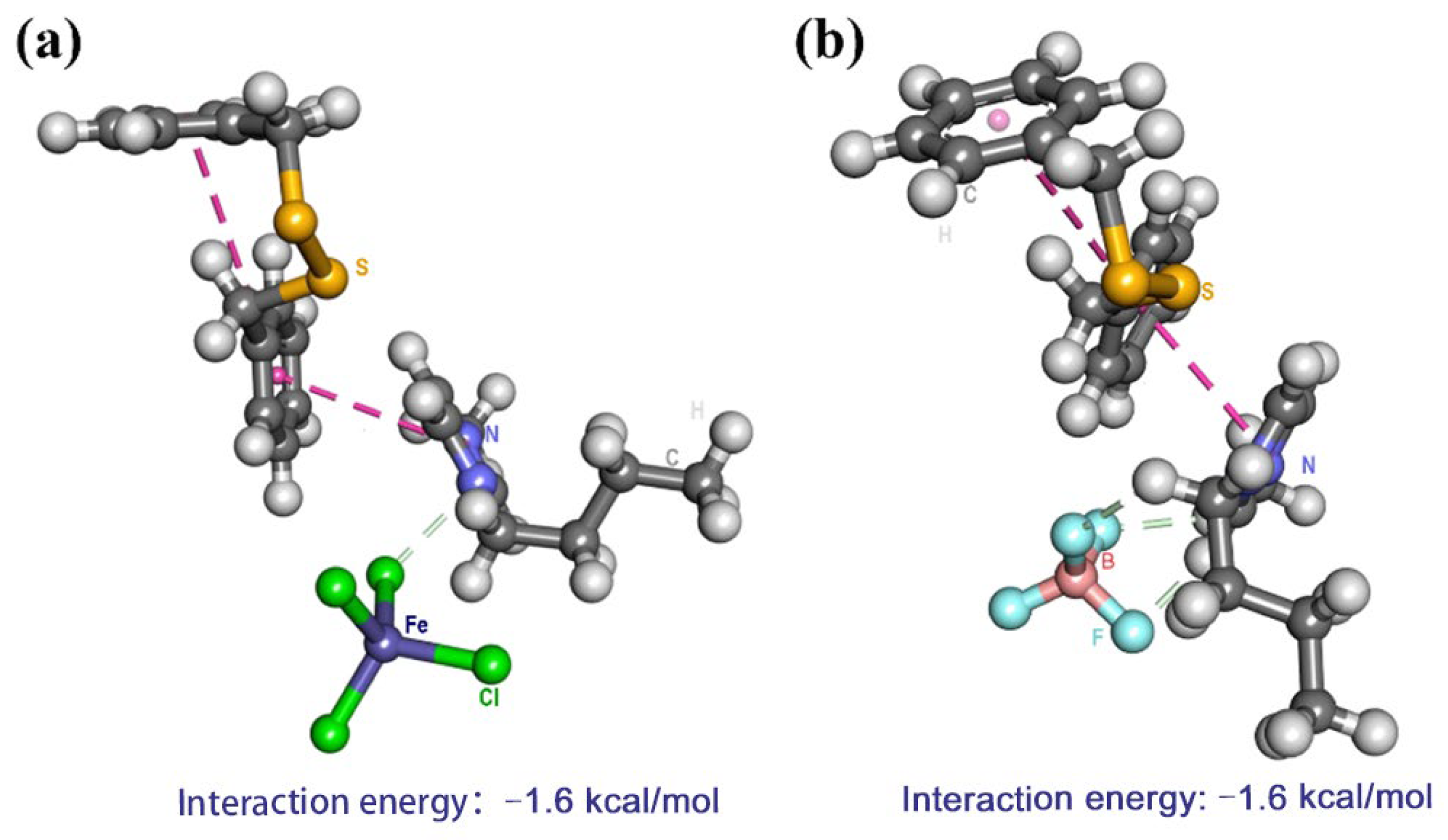

Disclaimer/Publisher’s Note: The statements, opinions and data contained in all publications are solely those of the individual author(s) and contributor(s) and not of MDPI and/or the editor(s). MDPI and/or the editor(s) disclaim responsibility for any injury to people or property resulting from any ideas, methods, instructions or products referred to in the content. |
© 2024 by the authors. Licensee MDPI, Basel, Switzerland. This article is an open access article distributed under the terms and conditions of the Creative Commons Attribution (CC BY) license (https://creativecommons.org/licenses/by/4.0/).
Share and Cite
Zhang, L.; Peng, P.; Pan, Q.; Wan, F.; Zhang, H. Extraction of Dibenzyl Disulfide from Transformer Oils by Acidic Ionic Liquid. Molecules 2024, 29, 2395. https://doi.org/10.3390/molecules29102395
Zhang L, Peng P, Pan Q, Wan F, Zhang H. Extraction of Dibenzyl Disulfide from Transformer Oils by Acidic Ionic Liquid. Molecules. 2024; 29(10):2395. https://doi.org/10.3390/molecules29102395
Chicago/Turabian StyleZhang, Lili, Pei Peng, Qian Pan, Fang Wan, and Huaxin Zhang. 2024. "Extraction of Dibenzyl Disulfide from Transformer Oils by Acidic Ionic Liquid" Molecules 29, no. 10: 2395. https://doi.org/10.3390/molecules29102395
APA StyleZhang, L., Peng, P., Pan, Q., Wan, F., & Zhang, H. (2024). Extraction of Dibenzyl Disulfide from Transformer Oils by Acidic Ionic Liquid. Molecules, 29(10), 2395. https://doi.org/10.3390/molecules29102395






